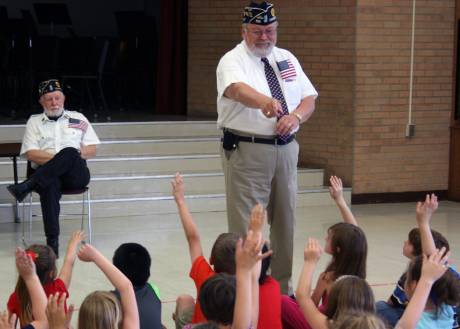
Press release:
On May 27, Byron-Bergen first-graders learned about the history and meaning of the United States' flag from people who proudly fought for it – prominent members of the Genesee County American Legion and Auxiliary. The students welcomed Genesee County American Legion Commander Dave Henry, Chaplain Don Nagle, Post & County Adjutant Jim Neider, and Auxiliary President Jane Fox, and listened intently to their presentation.
Neider, who was recently named to the New York State Veterans' Hall of Fame in honor of gallantry in the Armed Forces and service to the community, made history come alive with stories of Betsy Ross and the first flag. He explained that Flag Day – June 14 – celebrates the birthday of our national symbol. He described the meaning of the flag’s stars and stripes, and the significance of the red, white, and blue. He also encouraged the young patriots to remind their parents and other adults of the many ways to honor the flag.
“As vets, we enjoy helping children connect with history, and get an understanding for the importance of our flag and our country,” says Neider, who also taught elementary school for 30 years at Alexander Central School. “The kids at Byron-Bergen are especially knowledgeable and enthusiastic. They make doing this a lot of fun.”

FYI 1. Betsy Ross made the
FYI
1. Betsy Ross made the first American flag.
Five Myths
A feature from The Post’s Outlook section that dismantles myths, clarifies common misconceptions and makes you think again about what you thought you already knew.
Archive
.
The Betsy Ross story is the most tenacious piece of fiction involving the flag. There simply is no credible historical evidence — letters, diaries, newspaper accounts, bills of sale — that Ross (then known as Elizabeth Claypoole) either made or had a hand in designing the American flag before it made its debut in 1777.
The story cropped up in 1870, almost 100 years after the first flag was supposedly sewn, when William Canby, Ross’s grandson, told the Historical Society of Pennsylvania in Philadelphia that his grandmother made the flag at George Washington’s behest. Canby’s sole evidence: affidavits from family members. The iconic 1893 painting of Ross sitting in her Philadelphia parlor with the sun beaming down on the flag in her lap is a scene invented by Charles H. Weisgerber, the artist and entrepreneur who profited from the Betsy Ross legend.
While Ross did make flags in Philadelphia in the late 1770s, it is all but certain that the story about her creating the American flag is a myth.
As President Woodrow Wilson, who presided over the first official national Flag Day on June 14, 1916, is said to have replied when asked his thoughts on the story: “Would that it were true.”